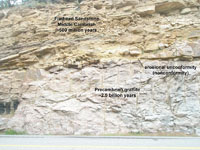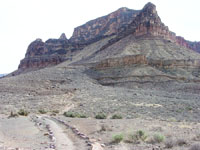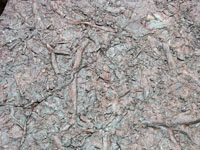2.9: Cambrian Period (540-485 million years)
- Page ID
- 9777
Highlights of the Early Paleozoic Era
Evolution of early plant and animal life (dominated mostly marine invertebrates) is revealed in the fossil record of the early part Paleozoic Era. Primitive land plants, insects, and the first vertebrates also appear.
Cambrian Period (540-485 million years)
The Cambrian Period is the oldest of the named geological periods of the Paleozoic Era. At the beginning of the Cambrian Period the combination of tectonic forces and erosion of the landscape allowed shallow seas to gradually cover much of North America. Shallow seas covered most of what is now the Great Basin, Rocky Mountains, and Great Plains in the west, and much of East Coast, Appalachian region, and most of the Midwest. The shallow seas withdrew at the end of Cambrian time, but what was left behind was a blanket of Cambrian sedimentary rocks, collectively called the Sauk Sequence (see Figures 2-20 and 2-21, also see Figure 2.13). The base of the Sauk Sequence rests on an eroded surface of ancient Precambrian-age (mostly metamorphic and igneous rocks of the core of more ancient mountain systems). This sequence boundary is called the Great Unconformity. The Great Unconformity is exposed in many places throughout the western United States, and is particularly well known from exposures along the base sedimentary rocks of Cambrian age exposed in the Grand Canyon within the canyons Inner Gorge (see Figure 2.14). The Great Unconformity can be traced across most of North America wherever the base of the Cambrian-age Sauk Sequence is exposed.
Calcareous skeletal shell remains first appear in the Cambrian Period.
The term Cambrian explosion refers to evidence in the fossil record which shows that all major phyla were established in the transition from latest Precambrian to the Early Cambrian Period (about 700 to 541 million years ago) (Figure 2.22). The cause of this radiation from earlier metazoan life forms is uncertain, but it may have been driven by global climate changes (hot to cold cycles) and the establishment of unique habitats (niches) which allowed species to evolve separately from common ancestors. In Cambrian time, escalation of predator-prey relationships and increased competition appears to have driven rapid evolution of new species (along with extinctions). In Cambrian time, shelled organisms first appear in abundance in sedimentary deposits preserved from that time period. The fossil record from Cambrian time show that organisms with chitonous and calcareous shells and exoskeletons appeared and diversified. Many Cambrian-age organisms have eyes, legs (or pods), spinal chord-like features, segmented body plans, and other unique body parts and characteristics. Representatives of all phyla from the Cambrian Explosion still exist in the world today (Figure 2.22). Sedimentary rocks from Cambrian Period are typically rich in evidence of life activity. They preserve an abundance of bioturbation features (also called trace fossils) even if the life forms that created them are not preserved (an example of bioturbation is shown in Figure 2.23).
Invertebrates dominate the fossil record in the early Paleozoic Era. An invertebrate is an animal lacking a backbone (spinal column or spinal chord), such as an arthropod, mollusk, annelid worm, coelenterate, echinoderm, and many others. The classification of invertebrates constitute a division of the animal kingdom, comprising about 95 percent of all animal species and about 30 different known phyla.
By the end of the Cambrian Period several groups of invertebrates were well established in shallow marine environments, perhaps most notably were trilobites, brachiopods, crinoids, bryozoans, sponges, and gastropods (snails) are locally common fossils preserved in Cambrian sedimentary rocks (Figures 2-24 and 2-25). At the end of the Cambrian Period, sea level fell and a long period of exposure and erosion occurred throughout North America and the other continents worldwide.
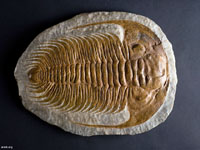 |
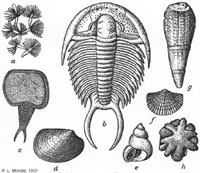 |
| Figure 2.24. Trilobites are common shelled fossils in sedimentary rocks from the Cambrian Period. | Figure 2.25. Cambrian fossils: trilobites, brachiopods, gastropods, and other invertebrates |



